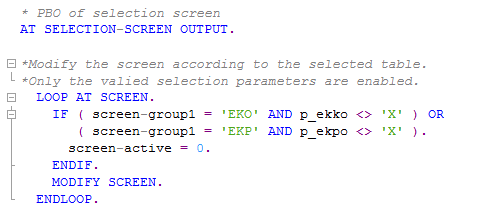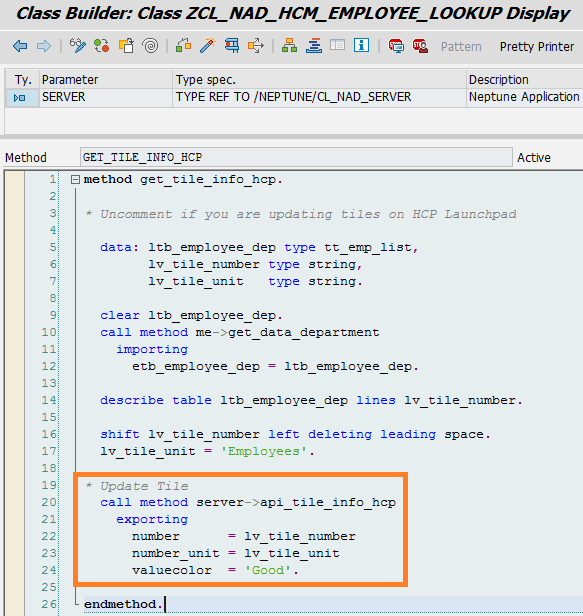Sap Abap Statement Dynamic
In ABAP/4 programming language, there are two types of SQL being used. Open SQL allows you to access the database tables declared in the ABAP dictionary regardless of the database platform that the R/3 system is using. Native SQL allows you to use.

AdvertisementBelow are the various types of actions that can be initiated:. Maintenance of another infotype/subtype. Sending an email. Calling a routineIn this tutorial, we will focus on the first action. The rationale for this is that the first action can be configured independently by a functional consultant, whereas implementing the others will need help from developer.Standard SAP Dynamic ActionsSAP provides several pre-configured SAP dynamic actions.
Let’s consider an example:If you have maintained the Personal data infotype (infotype 0002) for an employee in SAP, you may have observed that whenever the marital status is saved as “Married”, the system automatically proposes the creation of the Family member/dependents infotype (infotype 0021), subtype “Spouse”.This has been depicted in the following screenshots. AdvertisementHere, Figure 1 shows the Marital status being updated as “Married” using transaction code PA30 (Maintain HR master data). Figure 1: Transaction PA30 – Changing Marital StatusOn saving the record, the Create Family Member/Dependents screen is automatically displayed, as you can see in Figure 2. The subtype proposed is ‘Spouse’.Figure 2: Creation of Family Member/Dependents Automatically ProposedNow, the mechanism behind this behaviour is a simple SAP Dynamic action that has been pre-configured in the system. In the next section, we will look at how SAP Dynamic actions like this one can be configured.Configuration of SAP Dynamic ActionsThe configuration of SAP dynamic actions is done in Customizing using transaction code SPRO. Follow the path mentioned below and depicted in Figure 3:Personnel Management – Personnel Administration – Customizing Procedures – Dynamic Actions Figure 3: Dynamic Actions Path in SPROWhen you click on the Activity “Dynamic Actions”, it will take you to the screen in Figure 4.Figure 4: Dynamic Actions ConfigurationTo see the configuration of the dynamic action explained in the previous section, click on the ‘Position’ icon that has been highlighted in the above screenshot. This will take you to the pop-up shown in Figure 5.Figure 5: Position Pop-Up DialogNow, one question that may arise here is, which infotype should one enter in the above screenshot?

The answer is this – we need to search for the infotype that triggers the action, not the infotype being triggered by the action. So, in our example, we should search for Infotype 0002 (Personal data).Figure 6: Searching for Infotype 0002 (Personal Data)You will see several dynamic actions for Infotype 0002 as shown in Figure 7.Figure 7: Dynamic Actions for Infotype 0002To find out which dynamic action is relevant to our example, let us first understand the meaning and purpose of the various columns in this table. Look at the first three columns in this table, as highlighted in Figure 8.Figure 8: Infotype, Subtype, FieldThese columns respectively contain the Infotype, subtype and field that trigger the Dynamic action. AdvertisementThe column ‘Infotype’ is mandatory, as a dynamic action is triggered only on saving an infotype.The column ‘Subtype’ is optional and must be filled only if the Dynamic action should be triggered on saving a particular subtype of the infotype.The column ‘Field’ is also optional, and should be filled only if the Dynamic action should be triggered on saving a particular field of the infotype.Now, in our example, the Dynamic action is triggered on saving the ‘Marital status’ field in the infotype.
Sap Abap Dynamic If Statement
Hence let us further refine our search based on this field. Before doing this, we should find out the technical name of the field.
Cara membaca diagram psychrometric chart. The psychrometric chart: Step 1. Locate the dry bulb tem- perature along the bottom axis and the associated vertical line for each temperature. This scale will be. BAROMETRIC PRESSURE: 29.921 in. Normal Temperature.
To do this, execute transaction code SE11 and enter PA0002 as the Database table. PA0002 is the table that corresponds to infotype 0002 (Personal data).
Sap Abap Statement Dynamic Management
Click on the Display icon shown in Figure 9. Figure 9: Display PA0002This will take you to the screen shown in Figure 10. Search the Short description column for the Marital status field, we have highlighted it in the screenshot. You can see the field name is FAMST.Figure 10: Field NameLet’s use this field name to refine our search for the relevant Dynamic action as shown in Figure 11.Figure 11: Searching Using Infotype and Field NameSearching with both criteria, that is, Infotype 0002 (Personal data) and Field name FAMST (Marital status), takes us to the screen shown in Figure 12.Figure 12: SAP Dynamic Action for Infotype 0002 and Field FAMSTAgain, there are several entries for this combination of infotype and field. We will now try to understand the significance of the balance four columns of this table. AdvertisementFunction Character – This column is highlighted in Figure 13.
Select Statement In Abap
This indicates the infotype processing type for which the dynamic action should be triggered. Figure 13: Function CharacterIt can have the following values:00 – Independent of processing type02 – Change04 – Create06 – Change and Create08 – Delete10 – Change and Delete12 – Create and DeleteFor example, if you enter the Function character 02, the dynamic action will be triggered when the specified infotype is changed.If you enter the Function character 06, the dynamic action will be triggered when the specified infotype is created as well as when it is changed.The next three columns indicate the Sequence number, Step and Variable function part. While Sequence number is self-explanatory, the Step and Variable function part columns need a detailed explanation and hence we have dedicated a sub-section to these two columns.